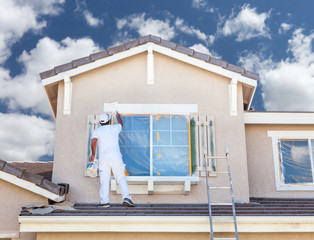A fresh coat of paint can completely transform the appearance of a home, creating a welcoming, vibrant, and polished look. House painting is more than just a cosmetic upgrade; it protects surfaces, enhances property value, and allows homeowners to express personal style. Whether tackling a single room, the exterior, or a full renovation, understanding the essentials of house painting ensures a successful, long-lasting result.

The Importance of House Painting
Painting is one of the most cost-effective ways to improve the look and feel of a home. Beyond aesthetics, painting serves several practical purposes:
- Protection – Paint acts as a barrier against moisture, sun damage, and other environmental factors, preventing wood, plaster, and siding from deteriorating.
- Maintenance – Regular painting helps maintain surfaces and prevents costly repairs from issues like rot, mold, or cracks.
- Curb appeal – A well-painted exterior enhances the overall impression of a home, which is especially important when selling or hosting guests.
- Personal expression – Choosing colors and finishes allows homeowners to reflect personality and style in their living spaces.
By combining functional and decorative benefits, painting is a worthwhile investment for every home.
Interior vs. Exterior Painting
The approach to painting depends on whether the work is indoors or outdoors. Both require preparation, the right materials, and proper techniques, but each presents unique challenges.
Interior painting focuses on aesthetics and durability, ensuring smooth, clean surfaces that complement the décor. It involves selecting suitable paint finishes, such as:
- Matte or flat – Hides imperfections and offers a smooth finish, ideal for ceilings and low-traffic areas.
- Eggshell or satin – Slightly glossy and easier to clean, perfect for living rooms and bedrooms.
- Semi-gloss or gloss – Highly durable and moisture-resistant, often used for kitchens, bathrooms, and trim.
Exterior painting prioritizes durability, weather resistance, and long-lasting protection. Exterior paints are formulated to withstand sun exposure, rain, temperature changes, and pests. Proper surface preparation, including cleaning, sanding, and priming, ensures the paint adheres well and lasts for years.
Preparing for a Painting Project
Preparation is key to achieving professional results. Neglecting prep work can lead to peeling, uneven coverage, and a less polished finish. Essential preparation steps include:
- Cleaning surfaces – Remove dust, dirt, grease, or mildew from walls and trim.
- Repairing imperfections – Fill cracks, holes, and dents, and sand surfaces for smoothness.
- Protecting areas – Cover floors, furniture, and fixtures with drop cloths or masking tape.
- Priming – Apply primer to raw, repaired, or stained surfaces to improve paint adhesion and durability.
Thorough preparation ensures that the paint goes on smoothly, adheres properly, and provides a lasting finish.
Choosing the Right Colors and Finishes
Color choice has a significant impact on the mood, perception, and style of a space. Lighter colors can make rooms feel larger and brighter, while darker shades add warmth and intimacy. Complementary tones, accent walls, and trim colors can further enhance visual appeal.
Finish selection also affects both appearance and performance. Matte finishes hide imperfections but are less washable, while glossy finishes offer durability and easy cleaning but can highlight flaws. For exteriors, high-quality, weather-resistant paints with UV protection help maintain vibrant colors over time.
Techniques for Professional Results
Achieving a flawless paint job requires proper technique. Common professional techniques include:
- Cutting in – Using a brush to paint edges and corners before using a roller for large surfaces.
- Rolling – Applying paint in even strokes to cover walls quickly and smoothly.
- Brushing – Ideal for detailed areas, trim, or touch-ups.
- Multiple coats – Applying two or more coats ensures even coverage, depth of color, and durability.
Patience and attention to detail during application prevent streaks, drips, and uneven coverage, resulting in a polished, long-lasting finish.
Hiring Professionals vs. DIY
While some homeowners enjoy painting as a DIY project, hiring professional painters offers several advantages:
- Experience and expertise – Professionals understand surface preparation, paint types, and application techniques.
- Efficiency – Trained teams complete projects faster with consistent quality.
- Safety – Professionals handle ladders, high surfaces, and potentially hazardous materials safely.
- Long-lasting results – Expert application reduces the likelihood of peeling, cracking, or uneven color.
Professional services can be especially valuable for large-scale projects, exterior work, or areas with intricate details.
Maintenance and Longevity
Proper maintenance prolongs the life of a paint job and keeps surfaces looking fresh. Tips for maintaining painted surfaces include:
- Regular cleaning – Wipe down interior walls and trim to remove dust and stains.
- Touch-ups – Address small chips or scratches promptly to prevent further damage.
- Inspections – Check exterior surfaces annually for peeling, cracking, or fading.
- Protecting surfaces – Use shades, awnings, or moisture barriers where possible to reduce sun or water damage.
Consistent upkeep ensures that painted surfaces remain attractive and functional for years.
Benefits Beyond Aesthetics
While appearance is often the primary reason for painting, it offers several additional benefits:
- Enhanced durability – Properly applied paint protects surfaces from wear and environmental damage.
- Improved indoor air quality – Low-VOC or eco-friendly paints reduce harmful emissions inside the home.
- Boosted property value – Fresh, attractive paint increases curb appeal and overall marketability.
By combining aesthetic, protective, and economic benefits, house painting contributes to a home’s overall quality and value.
House painting is a transformative process that enhances both the beauty and functionality of a home. Proper preparation, careful color and finish selection, expert techniques, and regular maintenance ensure long-lasting, high-quality results. Whether painting interiors or exteriors, DIY or professional services, a well-executed paint job protects surfaces, boosts property value, and creates spaces that are welcoming and enjoyable.
Investing in house painting is more than a cosmetic upgrade—it’s a way to safeguard your home, express personal style, and elevate everyday living. With attention to detail and a focus on quality, every painted surface can bring warmth, vibrancy, and renewed life to any home.